Starting April 2005, the new unemployment definition was adopted in the LFS per NSCB Resolution No. 15 dated October 20, 2004. The new definition is presented in the Technical Notes of this report. For comparative purposes, the July 2008 results are presented in the textual tables alongside with the final estimates for the July 2007 survey round.
About 64 percent of the population 15 years and over are in the labor force
The July 2008 LFS registered a labor force participation rate (LFPR) of 64.3 percent. This means that the size of the labor force in July 2008 was approximately 37.3 million out of the estimated 58.1 million population 15 years old and over. The LFPR was highest in Region X (Northern Mindanao) at 70.8 percent and lowest in Autonomous Region in Muslim Mindanao at 57.4 percent.
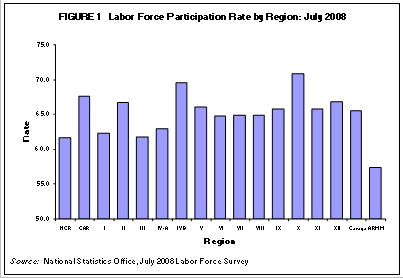
Employment rate registers at 92.6 percent
The employment rate estimated for July 2008 was 92.6 percent, indicating that nine in every ten persons in the labor force were employed. The current figure is not significantly different from the July 2007 rate of 92.2 percent.
Employment rate in the National Capital Region (87.2%), Central Luzon (90.6%) and CALABARZON (89.6%) were lower compared with other regions. As in previous LFS results, the National Capital Region recorded the lowest employment rate. Cagayan Valley recorded the highest employment rate of 97.1 percent, followed by Zamboanga Peninsula and Autonomous Region in Muslim Mindanao, both with 96.9 percent.
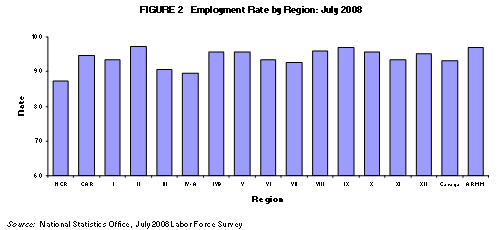
Employed males outnumber employed females
The employed population consisted of about 21.1 million males (61.1% of the total employed) and 13.5 million females (38.9%). The largest number of employed persons were in the age group 25 to 34 years, constituting more than one-fourth (26.4%) of the total employed. The age groups 35 to 44 years and 15 to 24 years followed with a share of 23.5 percent and 19.1 percent, respectively.

Services sector remains as the major source of employment
More than half (50.2%) of the 34.6 million employed persons worked in the services sector. About one-third (35.0%) were in the agriculture sector and the rest (14.8%) were in the industry sector.
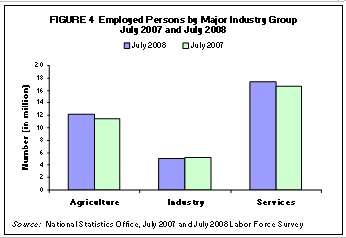
The agriculture sector increased by 5.3 percent from 11.5 million in July 2007 to 12.1 million in July 2008. The number of employed persons in the services sector increased by 4.3 percent. The increase was due to the increase of workers mainly in the four sub-sectors: wholesale and retail trade, repair of motor vehicles, motorcycles and personal and household goods (229 thousand), public administration and defense and compulsory social security (196 thousand), real estate, renting and business activities (127 thousand), and private household with employed persons (111 thousand).
The level of employment in the industry sector, on the other hand, decreased by 1.0 percent (54 thousand), from 5.2 million in July 2007 to 5.1 million in July 2008.
Almost one-third of employed population are laborers and unskilled workers
Among the various occupation groups, laborers and unskilled workers comprised the largest occupation group, posting 32.5 percent share, almost one-third of the employed population. Farmers, forestry workers and fishermen were the second largest group, accounting for 17.5 percent of the total employed persons.

More than half of total employed are wage and salary workers
Employed persons fall into any of these three categories: wage and salary workers, own account workers and unpaid family workers. Wage and salary workers are those who work for private establishments, government or government corporations and those who work with pay in own-family operated farm or business. More than half (52.9%) of the employed persons were wage and salary workers, more than one-third (35.5%) were own-account workers, and 11.6 percent were unpaid family workers. Among the wage and salary workers, those working for private establishments comprised the largest proportion (39.1% of the total employed). Government workers or those working for the government corporations comprised only 8.1 percent of the total employed, while 5.4 percent were workers in private households. Meanwhile, among the own account workers, the self employed comprised the majority (31.3% of the total employed).
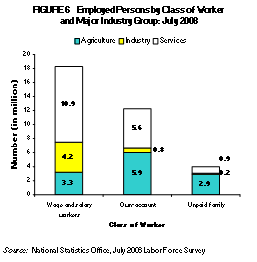
The increase in the number of wage and salary workers was contributed largely by the increase of workers in the services and agriculture sector (449 thousand and 239 thousand, respectively).
Two-thirds of employed persons work full-time
Employed persons are classified as either full-time workers or part-time workers. Full-time workers are those who worked for 40 hours or more while part-time workers, less than 40 hours. In July 2008, six in every ten employed persons (65.2%) were working for 40 hours or more, while part-time workers were estimated at 33.9 percent of the total employed.
One in every five employed workers wanted more hours of work
Employed persons who express the desire to have additional hours of work in their present job or to have additional job, or to have a new job with longer working hours are considered underemployed. The July 2008 LFS placed the underemployment rate at 21.1 percent. This means that approximately 7.3 million employed persons were underemployed in July 2008. More than half (55.8%) of the underemployed were reported as visibly underemployed, or had been working for less than 40 hours a week. Those working for 40 hours or more accounted for 42.6 percent of the total under employed. Most of the underemployed were working in the agriculture sector (46.9%) and services sector (38.1%). The underemployed in the industry sector accounted for 14.9 percent.
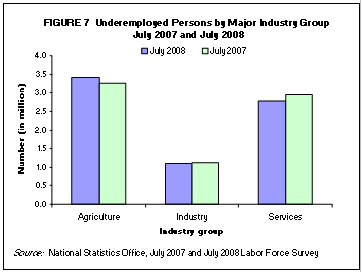
Unemployment rate reported at 7.4 percent
The unemployment rate in July 2008 was estimated at 7.4 percent. Among the regions, the highest unemployment rate was recorded in NCR at 12.8 percent. The next highest rates were posted in CALABARZON (10.4%) and Central Luzon (9.4%).
The number of unemployed was higher among males (61.8%) than among females (38.2%). By age group, for every 10 unemployed persons, five (51.8%) belonged to age group 15 to 24 years while three (28.5%) were in the age group 25 to 34 years.
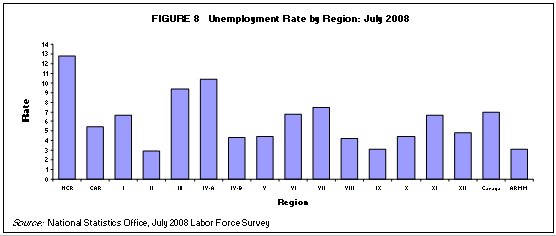
Across educational groups, the unemployed high school graduates comprised more than one-third (34.1%), the college undergraduates comprised about one-fifth (20.8%), while the college graduates, 19.5 percent.
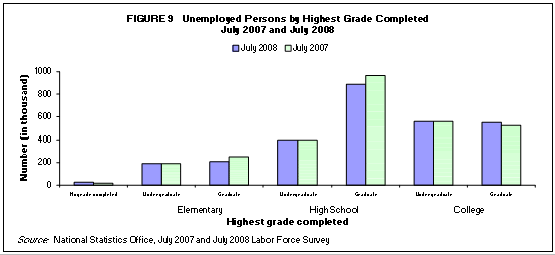
Seven in every ten persons not in the labor force are females
The number of persons not in the labor force like housewives, students, persons with disability, and retirees was estimated at 20.8 million in July 2008. This comprised 35.7 percent of the total population 15 years old and over. Seven in every ten persons who are not in the labor force were female.
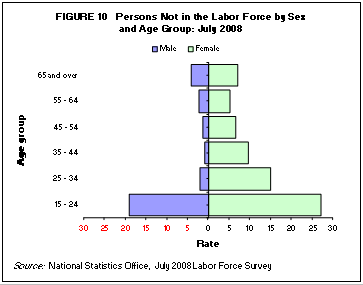
By age group, majority of those who were not in the labor force were below 35 years of age; that is 46.2 percent were 15 to 24 years old and 16.9 percent were 25 to 34 years old.
SUMMARY
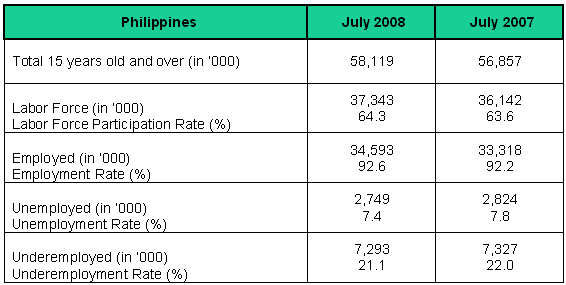
The number of persons in the labor force, or those who are either employed or unemployed was registered at 37.3 million, resulting to a labor force participation rate of 64.3 percent in July 2008.
The national employment rate was recorded at 92.6 percent in July this year.
Employed persons in the services sector reached 17.4 million in July this year, while those in the agriculture and industry sectors were estimated at 12.1 and 5.1 million, respectively.
The number of employed persons in the services sector increased by 4.3 percent in July 2008.
The number of wage and salary workers was estimated at 18.3 million, higher by 3.5 percent from the July 2007 figure of 17.7 million.
Employed persons who wanted or desired additional hours of work or those who were underemployed, were estimated at 7.3 million in July 2008.
The unemployment rate was reported at 7.4 percent in July 2008.
Among regions, the highest unemployment rate was recorded in the National Capital Region at 12.8 percent.
About 46 percent of the unemployed attained high school level.
Underemployment rate was estimated at 21.1 percent in July 2008.
TECHNICAL NOTES
The Labor Force Survey (LFS) is a nationwide quarterly survey conducted by the National Statistics Office (NSO). For this release, the data being presented are based on the final results of the July 2008 round of the LFS.
The reference period used in the survey is the past seven (7) days preceding the date of visit of the enumerator. The number of sample households was 51,000.
The concepts and definitions used in the survey can be found in the regular NSO-ISH Bulletins. Some are given below:
a. Labor Force - refers to the population 15 years old and over who contribute to the production of goods and services in the country. It comprises the employed and unemployed.
b. Employed - consists of persons in the labor force who are reported either as at work or with a job or business although not at work. Persons at work are those who did some work, even for an hour during the reference period.
c. Unemployed - consists of persons in the labor force who are reported as (1) without work; and (2) currently available for work; and (3) seeking work or not seeking work because of the belief that no work is available, or awaiting results of previous job application, or because of temporary illness or disability, bad weather or waiting for rehire or job recall.
Note: The new definition of unemployed was adopted starting April 2005 per NSCB Resolution No. 15 dated October 20, 2004
The old definition of unemployed considered only two criteria:
1) Without work and looking for work; or
2) Without work and not looking for work due to valid reasons.
d. Underemployed - refers to the employed persons who express the desire to have additional hours of work in their present job or an additional job, or have a new job with longer working hours.
e. Labor Force Participation Rate (LFPR) - proportion of total labor force to the total household population 15 years and over.
f. Employment Rate - proportion of employed persons to the total labor force.
g. Unemployment Rate - proportion of unemployed persons to the total labor force.
h. Underemployment Rate - proportion of underemployed persons to total employed persons.
Starting with the July 2003 round, the quarterly Labor Force Survey uses the 2003 Master Sample Design. Using this new master sample design, the number of samples increased from 41,000 to around 51,000 sample households.
The province of Basilan is now under Autonomous Region in Muslim Mindanao while Isabela City (Basilan) is under Region IX, in accordance with Executive Order No. 36.
The 1992 four-digit code for Philippine Standard Occupational Classification (PSOC) and 1994 Philippine Standard Industry Classification (PSIC) were used in classifying occupation and industry, respectively.
Starting with the January 2007 LFS round, the population projections based on the 2000 Census of Population has been adopted to generate the labor force statistics. This is in compliance with NSCB Resolution No. 1 series of 2005 entitled Adoption of the Methodology Used in Generating the 2000 Census of Population and Housing-Based National Population Projections.
Source: National Statistics Office
Manila, Philippines
